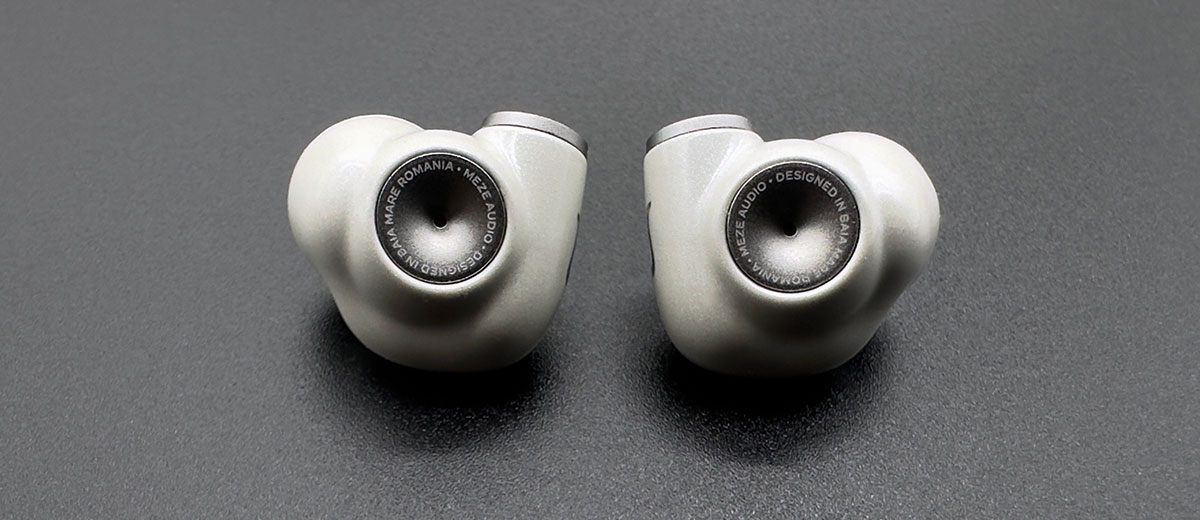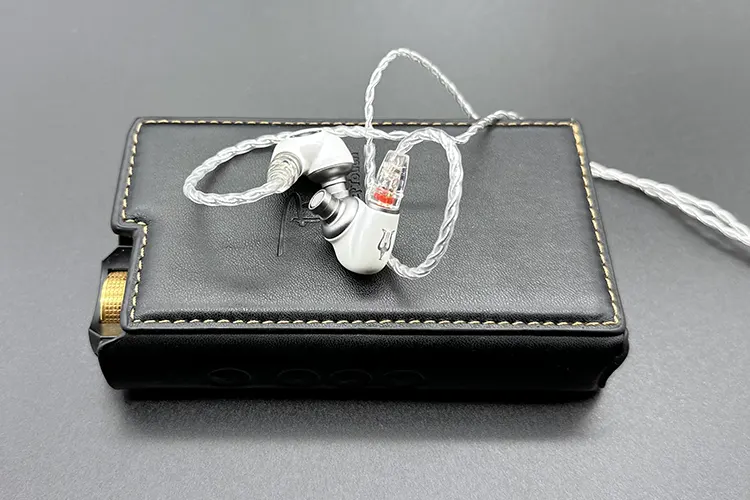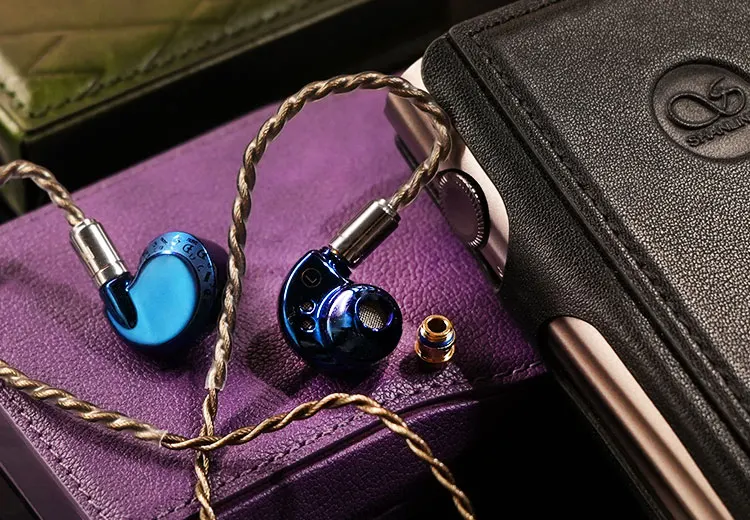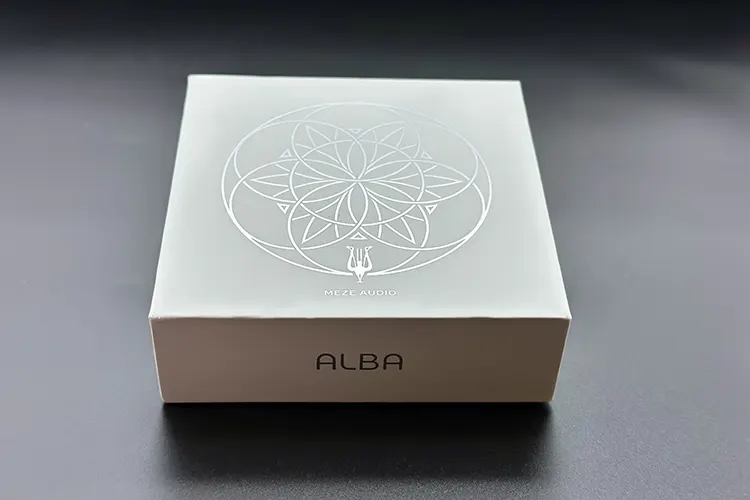Synergy
The Meze Audio ALBA has an impedance of 32Ω @1kHz and a sensitivity rating of 109 dB/Vrms. It is quite easy to drive the IEM, and the output is decent through various sources.
Devices such as smartphones and dongles will pair well with this IEM including smartphones and the latest iPhone with the inclusion of the USB-C to 3.5mm converter cable.
This makes ALBA an ideal IEM for people who want to listen directly from their phones using USB-C. The output using this converter is decent and clean enough to be enjoyable.
ALBA doesn’t require much power; however, when connected to more powerful devices, there is some improvement in sound quality. There is improved staging and dynamics from a powerful source.
It consistently delivers a clean output with very little if any background noise across various sources and dongles/DACs.
When paired with the Lotoo Paw Gold Touch, ALBA exhibits a solid bass presence and enhanced midrange richness. This is a fairly powerful DAP so you will hear a noticeable upgrade in output quality compared to smartphones and dongles.
I tried both the 3.5mm and 4.4mm balanced outputs and found the dynamics getting better on the balanced output.
Testing ALBA with the Earmen Angel, an even more powerful source, showed slight enhancements in dynamics. The Angel’s near-bright character adds a touch of airiness to the sound, creating a good synergy with ALBA.
There is no audible background noise, even at higher gain settings on the Angel, ensuring a consistently clean and quiet background.
Selected Comparisons
DUNU Falcon Ultra
Technical
The DUNU Falcon Ultra is a single dynamic driver IEM featuring a Lithium-Magnesium alloy diaphragm and an upgraded design from the previous generation.
With an impedance of 16Ω and a sensitivity of 108 dB @ 1 kHz/Vrms, the Falcon Ultra is easier to drive than the ALBA, requiring less power.
These IEMs come with two interchangeable nozzles: one made from stainless steel and the other from gold-plated brass. The stainless-steel nozzle delivers a brighter sound profile with enhanced energy in the upper mids and treble.
In contrast, the gold nozzle offers balanced tuning with a touch of warmth, de-emphasizing the upper frequencies.
Design
The Falcon Ultra shells feature an all-metal body in an attractive deep blue color. They are larger than the ALBA shells, offering a good fit, but the ALBA is better in terms of comfort.
The shells of Falcon Ultra are heavier, but they do not pose any threat to fit or comfort. I find DUNU more pleasing in terms of aesthetics.
The Falcon Ultra’s stock cable is a 4-core Silver-Plated Copper Litz design, featuring an MMCX connection and a modular structure.
It includes three different adapters: 3.5mm, 4.4mm, and 6.5mm. Compared to the cable on the ALBA, the Falcon Ultra’s cable stands out for its superior build quality and greater handling comfort.
When it comes to accessories, DUNU excels with the Falcon Ultra. It offers a comprehensive package that includes a wide variety of ear tips, modular cable, and a better carry case.
Performance
The bass performance of both IEMs is excellent, but the ALBA excels in producing deeper sub-bass frequencies, giving it an edge in low-end depth and rumble.
The bass on ALBA is a bit more refined, as the texture and layering have been done well on ALBA. The better quantity of bass adds more to the fun element of the ALBA.
In the midrange, there is more lushness and warmth in the Falcon’s sound. The midrange instruments have better tonality on the Falcon, however, the vocals on ALBA feel slightly denser compared to the DUNU.
I find the vocals more enjoyable on ALBA. Since the Falcon excels in technical aspects, the resolution is better on it, and the midrange comes across as cleaner.
In the treble region, DUNU has an edge. The Falcon Ultra brings the midrange to the forefront and emphasizes treble transients, enhancing the overall resolution. ALBA is not very far behind here.
Both of these IEMs bring out the treble details quite nicely, with the Falcon Ultra exhibiting an airier character.
In terms of technical aspects, these are quite close to each other. The soundstage is nearly similar in width on both IEMs, while the depth is better on the DUNU. The imaging quality is nearly the same on both.
The Falcon Ultra is ahead in resolution and portrays cleaner images. While ALBA does not miss out on any details, even on busy tracks, Falcon Ultra brings out more detail.
ORIVETI OD200
Technical
The ORIVETI OD200 is a custom-tuned beryllium-coated 9.8mm single dynamic driver IEM. It has an impedance of 16Ω and a sensitivity of 108 dB @1kHz/Vrms.
The OD200 is easier to drive than the ALBA but it can pick up on hiss and noise when paired with powerful high-gain floor amplifiers.
The OD200 comes with interchangeable nozzle filters in black and silver. The silver nozzle adds a bit to the lower and mid-bass, and the treble is less sharp on it compared to the black nozzle.
Design
The OD200 features a compact and lightweight all-metal body with a subtle British racing green finish. In contrast, the ALBA has even smaller and lighter shells.
While the OD200 boasts a universal design that eliminates fit issues, the ALBA offers a superior fit owing to its tiny shells. Additionally, the ALBA excels in noise isolation, blocking significantly more external noise than the OD200.
The cable that comes with OD200 is a modular cable with both 3.5mm and 4.4mm terminations. The quality of this cable is a lot better than the one that comes with the ALBA.
When it comes to accessories, the OD200 has a lot better packaging. It offers a decent package that includes a wide variety of ear tips, modular cable, and a better carry case. ALBA lacks an overall unboxing experience with its limited offerings.
Performance
The OD200 features a thick bass texture with a noticeable midbass boost. While the OD200 delivers a similar quantity of bass, the ALBA excels with superior quality, making it more appealing.
However, the OD200 suffers from some bass bleeding into the midrange, which affects the upper frequencies. The layering and texture in the bass are a lot better on the ALBA.
The OD200 exhibits a more musical quality to its midrange with a greater weight to the notes. I found the midrange to be more organic and richer on the OD200.
In contrast, the ALBA offers a more neutral and less warm midrange but more competitive in terms of clarity and resolution.
The treble on the OD200 lacks energy and airiness, while the ALBA offers more details in the upper frequencies. The OD200’s sound is veiled and dark, causing a lot of detail to be muted or obscured.
The ALBA reveals these nuances, delivering a more balanced sound signature that preserves all frequency ranges without compromise.
In terms of technical aspects, I would rate these IEMs close. The soundstage on both the IEMs is nearly comparable, with the OD200 having a better sense of depth and height.
There is more openness to sound with the ALBA owing to better upper-frequency tuning. The imaging capability is also equally good on both of these IEMs.
My Verdict
When the Advar was released, it received some polarizing reviews. Some praised its tuning, while others found the upper-frequency range harsh.
With the ALBA, Meze Audio has created a safer and more universally appealing IEM. If Advar’s tuning does not suit someone’s taste, they will likely find the ALBA much more agreeable.
The ALBA’s tuning boasts some of the most enjoyable sets of lows among competing budget IEMs, with a balanced tuning that covers every frequency range well, producing a musical and fun sound. Its design and build quality make it ideal for long-term use.
Additionally, the inclusion of a USB-C to 3.5mm converter DAC/amp expands its compatibility with a variety of devices. The only downside I can see is the packaging, which is a bit unimpressive due to its sparse contents. However, considering the price range, it’s just a nitpick.
Overall, I am very impressed with the Meze ALBA, getting a solid recommendation from me.
Meze Audio ALBA Specifications
- Driver: 10.8mm dynamic driver
- Frequency Range: 15Hz – 25kHz.
- Impedance: 32Ω
- Sensitivity: 109 dB
- Materials: zinc alloy and anodized aluminum.
- Connector Type: 0.78mm 2-pin
- Termination Plug: 3.5mm Single-Ended Termination.






